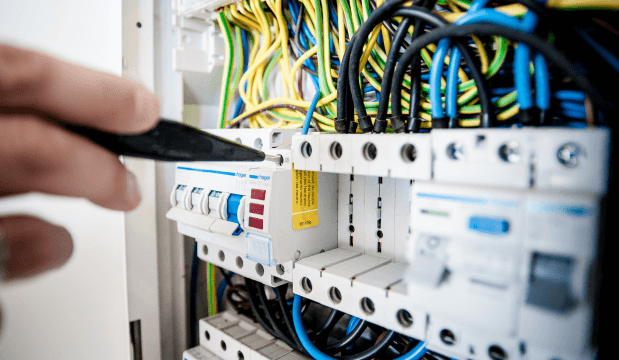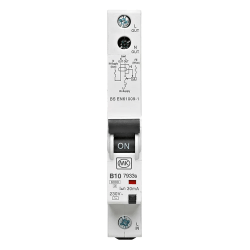Intro
Circuit protection devices are essential for electrical installations. They protect devices from damage by disconnecting the power when overcurrents and earth faults are detected. This helps prevent fires and keeps consumers safe from electrocution.
Protection devices such as RCDs are also mandatory in domestic properties for electrical circuits to comply with 18th Edition Wiring Regulations.
Overcurrents
What is an overcurrent?
A flow of electricity larger than the normal and safe level for a circuit is called an overcurrent. These can be the result of overloads, short circuits, and ground faults. Without an overcurrent protection device, such as a circuit breaker, they can lead to fires, electric shocks, and damage to electrical equipment.
Circuit Breakers
What are circuit breakers?
Circuit breakers are electrical protective devices found inside consumer units. Their role is to automatically disconnect the current flow in a circuit when there is a fault. They can also be manually controlled. Unlike fuses, they can be reset, making them a recommended alternative.
How does a circuit breaker work?
Circuit breakers have a switch connected to an electromagnet or a bimetallic strip.
Electromagnet - In a circuit breaker with an electromagnet, the current flowing through the circuit affects the electromagnet's magnetic force. When the current increases, the magnetism also increases. If the current flowing is larger than the safe limit for the installation, the electromagnet’s force becomes strong enough to pull down a metal lever, which breaks the circuit. This type of circuit breaker is resilient to small increases in amperage but will quickly trip when faults occur
Bimetallic Strip - A circuit breaker with a bimetallic strip contains two metals that heat up as current flows through them. As the strips of metal grow hotter, they curl. If there is an overcurrent, the strips will curl so much that they trip the switch. This breaks the circuit.
They are not suitable for applications where short circuit currents could be large enough to weld the bimetallic strips together. As the strips curl slowly, only long-term overloads will cause this type of circuit breaker to trip.
Thermal-Magnetic - Thermal-magnetic circuit breakers contain both electromagnets and bimetallic strips. They protect against overloads and short circuits.
Single pole circuit breakers
Single pole circuit breakers are commonly used for domestic applications, they will only disconnect the live cable from the circuit in the event of a fault. They monitor the current flow in a single wire and trip when there is an overcurrent. An example of where a single pole circuit breaker is used is in the lighting of a house. These breakers usually only occupy one way of a consumer unit.
Double pole circuit breakers
A double pole circuit breaker, measures the current through two wires simultaneously and trips if there is an overcurrent in one or both wires. If an overcurrent occurs in either of the poles, the breaker will trip both circuits. These are usually used in properties where the live and neutral need to be isolated for maximum protection.
MCBs
How do MCBs work?
MCBs contain a bimetallic switch or an electromagnet, which causes the switch to trip when there is an overload. For more information on how this works, check out the circuit breaker section on this guide page.
How to choose the correct current rating for an MCB
MCBs come in a range of amperages, but those used in domestic installations usually have a breaking capacity of 6kA. When choosing the current rating for an MCB, ensure it is equal to or greater than the current the installation is expected to carry, but no larger than the maximum current capacity for the circuit.
Using an MCB with a lower current rating than the total current in a circuit may cause it to trip unnecessarily. For example, if the total current in a circuit is 12A, then an MCB of 16A would be needed.
What are the different types of MCB?
MCBs come in different types, including A, B, C, D, K, and Z. MCB types refer to the device’s trip curve, which is the maximum current the circuit breaker can withstand before it trips.
RCDs
How does an RCD work?
Inside an RCD current from a live wire passes into a coil wrapped around an iron core called a toroid. This generates a magnetic field. As the current flows back from the circuit into the RCD through a neutral wire, it passes through a coil wired the opposite way to the live cable. This creates another magnetic field. When the currents from both are equal, the magnetic fields cancel each other out.
If there is an earth fault, the magnetic fields become unbalanced. This causes net electromagnetism which generates a current. The current then passes into a detector coil connected to the toroid, causing the circuit breaker to trip.
What are the main types of RCD?
There are three main types of RCD. These are Type AC, Type A, and Type B.
When should you use an RCD with an extension cable?
If an extension lead is less than 15m, used indoors, and plugged into a socket already protected by an RCD, then an additional residual current device is not required. However, if an extension lead is used outside, it is highly recommended to fit it with an RCD. Especially when it is unclear if the appliances are RCD protected.
RCBOs
Consumer Units
Do plastic consumer units need to be replaced?
The enclosure of a fusebox must be made of fireproof material or placed within a non-combustible casing to comply with 18th Edition Wiring Regulations. This makes steel a popular choice of material as it stops fires from spreading if they occur due to an electrical fault. Plastic fuseboxes are less safe than metal alternatives but are compliant with regulations as long as they are housed in a non-combustible unit.
What are the ways on a consumer unit?
The amount of ways on a consumer unit are the number of outgoing paths for current to flow into circuits. Therefore, larger properties are likely to need more ways. To work out the number of useable ways on a consumer unit, take away the number of ways the main switch, any SPDs, and RCDs take up from the total number of ways.
Disclaimer: The product statements contained herein are intended for informational purposes only. Such product statements do not constitute a product recommendation or representation as to the appropriateness for a specific application or use. Builder Depot does not guarantee the result of product operation or assume any liability for personal injury or property damage resulting from the use of such products.











